Do you have a question about the Yamaha YZ450F and is the answer not in the manual?
Identifies and illustrates the location of all crucial labels on the vehicle for user reference.
Provides a detailed overview and identification of various parts of the motorcycle.
Explains how to find and understand the VIN, engine serial number, and model label.
Details the vehicle's main features, including an overview of the Fuel Injection (FI) system.
Lists and illustrates the parts that come with the vehicle, such as tools and accessories.
Covers essential guidelines for preparation, disassembly, and replacement parts.
Lists specialized tools required for accurate adjustment, assembly, and maintenance.
Explains the operation and location of all main controls like levers, pedals, and switches.
Provides key general data for the motorcycle including dimensions, weight, and model variations.
Details all technical specifications related to the engine, including displacement, bore, stroke, and oil types.
Lists technical data for the chassis, wheels, tires, brakes, and suspension systems.
Provides detailed specifications for the ignition, charging, and engine control systems.
Specifies the correct torque values for various fasteners throughout the motorcycle.
Identifies all lubrication points and the recommended lubricant types for engine and chassis.
Outlines the recommended inspection and maintenance schedule based on time or usage.
Details essential checks to be performed before operating the vehicle for the first time or for racing.
Provides a general overview of inspection points for critical systems like coolant, fuel, and brakes.
Covers procedures for checking and adjusting engine components like coolant level and oil.
Details checks and adjustments for chassis components including brakes, chain, and suspension.
Explains how to check electrical components such as spark plugs, ignition coils, and sensors.
Covers removal and installation of common chassis parts like seat, side covers, and number plate.
Details the removal, checking, disassembly, assembly, and installation of the front wheel.
Covers the removal, checking, disassembly, assembly, and installation of the rear wheel.
Explains procedures for removing, disassembling, checking, and assembling the front brake caliper and master cylinder.
Details the removal, disassembly, checking, and assembly of the rear brake caliper and master cylinder.
Covers the removal, checking, and installation of the handlebar and its related controls.
Provides procedures for removing, disassembling, checking, and assembling the front fork legs.
Details the removal, checking, adjustment, and installation of the steering head components.
Covers handling, disposal, removal, checking, and installation of the rear shock absorber assembly.
Explains the removal, checking, and installation procedures for the swingarm and its related components.
Details the removal, checking, cleaning, and installation of the drive chain and sprockets.
Outlines the step-by-step process for removing the engine and its related components.
Covers the removal, checking, and installation of the camshaft and related parts.
Details the removal, checking, and installation of the cylinder head and its components.
Explains the removal, checking, and installation of valves, springs, and related parts.
Covers the removal, checking, and installation of the cylinder, piston, and piston rings.
Details the removal, checking, and installation of clutch components like plates, springs, and housing.
Explains the removal, checking, and installation of the kick starter shaft and related gears.
Covers the removal, checking, and installation of the shift shaft, forks, and related components.
Details the removal, checking, and installation of the oil pump and balancer gear assemblies.
Explains the removal, checking, and installation of the AC magneto and stator assembly.
Covers the separation, disassembly, checking, and assembly of the crankcase.
Details the removal, checking, and installation of the crankshaft and balancer shaft assemblies.
Explains the removal, checking, and installation of the transmission, shift drum, and shift forks.
Covers the removal, handling, checking, and installation of the radiator and its hoses.
Details the removal, checking, and assembly of the water pump and its components.
Covers the removal, installation, and checking of the fuel tank and fuel pump.
Details the removal, checking, and adjustment of the throttle body and related sensors.
Covers the circuit diagram, troubleshooting, and checking of ignition system components.
Details the circuit diagram, troubleshooting, and checking of the charging system components.
Covers circuit diagrams, diagnostic tools, and troubleshooting for the fuel injection system.
Provides circuit diagrams and troubleshooting steps for the fuel pump system.
Illustrates and lists the location of various electrical components on the motorcycle.
Provides general guidance and refers to specific procedures for troubleshooting various issues.
Lists common causes and checks for engine starting problems.
Addresses potential causes and solutions for abnormal engine idling speeds.
Details common clutch problems like slipping or dragging and their potential causes.
Identifies causes for engine overheating and cooling system issues.
Lists potential causes for reduced braking performance and safety concerns.
Addresses issues related to front fork oil leaks, bent tubes, or damaged components.
Covers potential causes for poor vehicle stability, including chassis and suspension issues.
Provides a list of diagnostic codes and corresponding fail-safe actions for the FI system.
Guides the selection of drive and driven sprockets for optimal performance based on riding conditions.
Recommends adjusting tire pressure based on road surface conditions for optimal grip and safety.
Explains how to adjust front fork settings for air spring, spring preload, and damping force.
Covers setting the spring preload and damping force for the rear shock absorber.
Provides a table for diagnosing and adjusting front fork settings based on specific symptoms.
Offers a table for diagnosing and adjusting rear shock absorber settings based on handling symptoms.
Identifies and illustrates the location of all crucial labels on the vehicle for user reference.
Provides a detailed overview and identification of various parts of the motorcycle.
Explains how to find and understand the VIN, engine serial number, and model label.
Details the vehicle's main features, including an overview of the Fuel Injection (FI) system.
Lists and illustrates the parts that come with the vehicle, such as tools and accessories.
Covers essential guidelines for preparation, disassembly, and replacement parts.
Lists specialized tools required for accurate adjustment, assembly, and maintenance.
Explains the operation and location of all main controls like levers, pedals, and switches.
Provides key general data for the motorcycle including dimensions, weight, and model variations.
Details all technical specifications related to the engine, including displacement, bore, stroke, and oil types.
Lists technical data for the chassis, wheels, tires, brakes, and suspension systems.
Provides detailed specifications for the ignition, charging, and engine control systems.
Specifies the correct torque values for various fasteners throughout the motorcycle.
Identifies all lubrication points and the recommended lubricant types for engine and chassis.
Outlines the recommended inspection and maintenance schedule based on time or usage.
Details essential checks to be performed before operating the vehicle for the first time or for racing.
Provides a general overview of inspection points for critical systems like coolant, fuel, and brakes.
Covers procedures for checking and adjusting engine components like coolant level and oil.
Details checks and adjustments for chassis components including brakes, chain, and suspension.
Explains how to check electrical components such as spark plugs, ignition coils, and sensors.
Covers removal and installation of common chassis parts like seat, side covers, and number plate.
Details the removal, checking, disassembly, assembly, and installation of the front wheel.
Covers the removal, checking, disassembly, assembly, and installation of the rear wheel.
Explains procedures for removing, disassembling, checking, and assembling the front brake caliper and master cylinder.
Details the removal, disassembly, checking, and assembly of the rear brake caliper and master cylinder.
Covers the removal, checking, and installation of the handlebar and its related controls.
Provides procedures for removing, disassembling, checking, and assembling the front fork legs.
Details the removal, checking, adjustment, and installation of the steering head components.
Covers handling, disposal, removal, checking, and installation of the rear shock absorber assembly.
Explains the removal, checking, and installation procedures for the swingarm and its related components.
Details the removal, checking, cleaning, and installation of the drive chain and sprockets.
Outlines the step-by-step process for removing the engine and its related components.
Covers the removal, checking, and installation of the camshaft and related parts.
Details the removal, checking, and installation of the cylinder head and its components.
Explains the removal, checking, and installation of valves, springs, and related parts.
Covers the removal, checking, and installation of the cylinder, piston, and piston rings.
Details the removal, checking, and installation of clutch components like plates, springs, and housing.
Explains the removal, checking, and installation of the kick starter shaft and related gears.
Covers the removal, checking, and installation of the shift shaft, forks, and related components.
Details the removal, checking, and installation of the oil pump and balancer gear assemblies.
Explains the removal, checking, and installation of the AC magneto and stator assembly.
Covers the separation, disassembly, checking, and assembly of the crankcase.
Details the removal, checking, and installation of the crankshaft and balancer shaft assemblies.
Explains the removal, checking, and installation of the transmission, shift drum, and shift forks.
Covers the removal, handling, checking, and installation of the radiator and its hoses.
Details the removal, checking, and assembly of the water pump and its components.
Covers the removal, installation, and checking of the fuel tank and fuel pump.
Details the removal, checking, and adjustment of the throttle body and related sensors.
Covers the circuit diagram, troubleshooting, and checking of ignition system components.
Details the circuit diagram, troubleshooting, and checking of the charging system components.
Covers circuit diagrams, diagnostic tools, and troubleshooting for the fuel injection system.
Provides circuit diagrams and troubleshooting steps for the fuel pump system.
Illustrates and lists the location of various electrical components on the motorcycle.
Provides general guidance and refers to specific procedures for troubleshooting various issues.
Lists common causes and checks for engine starting problems.
Addresses potential causes and solutions for abnormal engine idling speeds.
Details common clutch problems like slipping or dragging and their potential causes.
Identifies causes for engine overheating and cooling system issues.
Lists potential causes for reduced braking performance and safety concerns.
Addresses issues related to front fork oil leaks, bent tubes, or damaged components.
Covers potential causes for poor vehicle stability, including chassis and suspension issues.
Provides a list of diagnostic codes and corresponding fail-safe actions for the FI system.
Guides the selection of drive and driven sprockets for optimal performance based on riding conditions.
Recommends adjusting tire pressure based on road surface conditions for optimal grip and safety.
Explains how to adjust front fork settings for air spring, spring preload, and damping force.
Covers setting the spring preload and damping force for the rear shock absorber.
Provides a table for diagnosing and adjusting front fork settings based on specific symptoms.
Offers a table for diagnosing and adjusting rear shock absorber settings based on handling symptoms.
| Displacement | 449cc |
|---|---|
| Bore x Stroke | 97.0 mm x 60.8 mm |
| Transmission | 5-speed |
| Final Drive | Chain |
| Width | 32.5 in |
| Seat Height | 38.2 in |
| Wheelbase | 58.5 in |
| Fuel Capacity | 1.6 gal |
| Fuel System | Fuel Injection |
| Front Suspension | KYB® Speed-Sensitive System inverted fork; fully adjustable, 12.2-in travel |
| Front Brakes | Hydraulic single disc, 270mm |
| Rear Brakes | Hydraulic single disc |
| Front Tire | 80/100-21 |
| Rear Tire | 120/80-19 |
| Wet Weight | 245 lbs |
| Engine Type | Liquid-cooled, 4-stroke, DOHC, 4-valve |

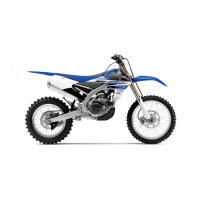


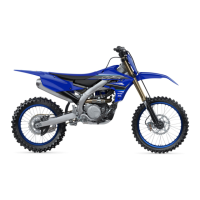
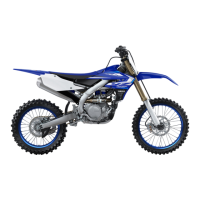



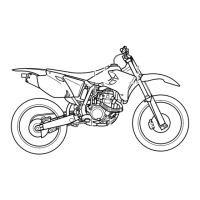

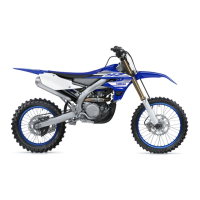
